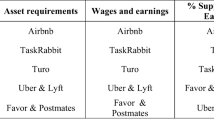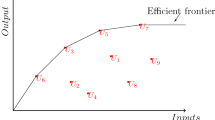Abstract
This study provides evidence on the nature and extent of the effect of Internet usage or penetration on labor productivity growth, while focusing on the recent experience in OECD countries. The basic model modifies the traditional labor-augmented production function approach by integrating Internet usage as a factor that improves labor quality. Variables on output, capital, and labor are extracted from official OECD publications, and data on the penetration ratio, a proxy for Internet usage, is obtained from an online source. The result is a panel that covers 28 OECD countries, including the U.S., over the time period from 2001 through 2016. Parameter estimates for Internet usage across the models are found to be positive, albeit with low statistical support. Based on a unique historical survey data set for the U.S. that separates Internet use at home from the use at work, a descriptive analysis for the U.S. suggests that growth of Internet use at work lowers productivity growth.
Similar content being viewed by others
Notes
Calculations from the data published by the U.S. Bureau of Labor Statistics show that, starting from 1970, the 10-year average non-farm labor productivity (output per hour) growth rates are 1.79% (1971–1980), 1.66% (1981–1990), 2.22% (1991–2000), 2.67% (2001–2010), and 0.67% (2011–2017). During the 10-year period from 1996 through 2005, the average rate of growth of labor productivity reached a high of 3.01%, regardless of the dot.com collapse at the turn of the new century. Even after the outbreak of the 2008 financial crisis, U.S. labor productivity growth reached 3.5% and 3.4% in 2009 and 2010, although it then started to dwindle after 2010, respectively, but still showed positive growth.
During the same time period, the 10-year average real annual GDP growth rates are 3.31% (1971–1980), 3.21% (1981–1990), 3.61% (1991–2000), 1.75% (2001–2010), and 2.11% (2011–2017). For 1996 through 2005, the 10-year average is 3.46%.
See the literature review in Najarzadeh, Rahimzadeh, and Reed [19].
To be explained more carefully in the text, the empirical estimations include data on the 28 OECD member countries.
It is possible that there may be reverse feedbacks, whereby TFP growth affects Internet usage. However, given the lags associated with such feedbacks, the main direction of causality seems to run from Internet usage to productivity (also see Mastromarco and Zago [18]).
Internet usage could alternatively be measured by broadband subscriptions (see https://data.worldbank.org/indicator/IT.NET.BBND.P2). However, since many businesses might have Internet access but not broadband subscriptions, Internet subscriptions would seem to better capture the impact of the Internet on productivity.
Another possibility could be that the growth of the Internet could have spillovers on some white-collar crimes (see [6]), which could undermine productivity.
Treating human capital as a separate stock of capital from physical capital, Eq. (1) can be re-specified as
$$ Y(t)=A(t)K{(t)}^{\alpha }H{(t)}^{\gamma }{\left[q\left(I(t)\right)L(t)\right]}^{\beta },\kern0.5em \mathrm{and}\ q={aI}^b $$where H is human capital, and the growth Eq. (6) becomes:
$$ \dot{Y}-\dot{L}=\dot{A}+\alpha \dot{K}+\gamma \dot{H}+\beta b\dot{I}+\left(\beta -1\right)\dot{L} $$When treating human capital as another labor-quality-augmenting factor, Eq. (1) becomes
$$ Y(t)=A(t)K{(t)}^{\gamma }{\left[q\left(I(t),H(t)\right)L(t)\right]}^{\beta },\kern0.5em \mathrm{and}\ q={aI}^b{H}^c, $$and Eq. (6) becomes:
$$ \dot{Y}-\dot{L}=\dot{A}+\alpha \dot{K}+\beta c\dot{H}+\beta b\dot{I}+\left(\beta -1\right)\dot{L} $$
References
Belleflamme, P. (2001). Oligopolistic competition, IT use for product differentiation and the productivity paradox. International Journal of Industrial Organization, 19(1–2), 227–248.
Blinder, A. S. (2000). The internet and the new economy. Policy Brief #60 (pp. 1–8). Washington D.C.: the Brookings Institution.
Cassiman, B., & Sieber, S. (2002). The impact of internet on market structure. Chapter 14. In I. A. J. Salazar & S. Sawyer (Eds.), Handbook of Information Technology in Organizations and Electronic Markets (pp. 299–322). World Scientific Publishing, Co.. https://doi.org/10.1142/9789812707628_0015.
Drukker, D. M. (2003). Testing for serial correlation in linear panel-data models. The Stata Journal, 3(2), 168–177.
Freeman, R. B. (2002). The labor market in the new information economy. Oxford Review of Economic Policy, 18(3), 288–305.
Goel, R. K. (2019). Identity theft in the internet age: Evidence from the U.S. states. Managerial and Decision Economics, 40(2), 169–175.
Goel, R. K., & Hsieh, E. W. T. (2002). Internet growth and economic theory. Netnomics, 4(2), 221–225.
Goss, E. P. (2001). The Internet’s contribution to U.S. productivity growth: Putting some rigor into the estimates. Business Economics, 36(4), 32–42.
Goss, E., & Phillips, J. M. (2002). How information technology affects wages: Evidence using Internet usage as a proxy for IT skills. Journal of Labor Research, 23(3), 463–474.
Haucap, J., & Heimeshoff, U. (2014). Google, Facebook, Amazon, eBay: Is the internet driving competition or market monopolization? International Economics and Economic Policy, 11(1–2), 49–61.
Harris Interactive. (2009). http://s3.amazonaws.com/zanran_storage/www.harrisinteractive.com/ContentPages/110527515.pdf. Last accessed 17 September 2019.
Jorgenson, D. W. (1999). Productivity growth: Current recovery and longer-term trends–information technology and growth. American Economic Review. 89(2):109–115.
Jorgenson, D. W. (2001). Information technology and the U.S. economy. American Economic Review, 91(1), 1–32.
Jorgenson, D. W., & Stiroh, K. J. (2000). Raising the speed limit: U.S. economic growth in the information age. Brookings Papers on Economic Activity, 1, 125–211.
Ketteni, E. (2009). Information technology and economic performance in U.S. industries. Canadian Journal of Economics, 42(3), 844–865.
Lehr, W., & Lichtenberg, F. (1999). Information technology and its impact on firm-level productivity: Evidence from government and private data sources, 1977-1993. Canadian Journal of Economics, 32(2), 335–362.
Litan, R. E., & Rivlin, A. M. (2001). Projecting the economic impact of the internet. American Economic Review, 91(2), 313–317.
Mastromarco, C., & Zago, A. (2012). On modeling the determinants of TFP Growth. Structural Change and Economic Dynamics, 23(4), 373–382.
Najarzadeh, R., Rahimzadeh, F., & Reed, M. (2014). Does the internet increase labor productivity? Evidence from a cross-country dynamic panel. Journal of Policy Modeling, 36(6), 986–993.
Nurmilaakso, J.-M. (2009). ICT solutions to labor productivity: Evidence from firm-level data. Electronic Commerce Research, 9(3), 173–181.
Oliner, S. D., & Sichel, D. E. (2000). The resurgence of growth in the late 1990s: Is information technology the story? Journal of Economic Perspectives, 14(4), 3–22.
Stiroh, K. J. (2002). Information technology and the U.S. Productivity Revival: What Do the Industry Data Say? American Economic Review, 92(5), 1559–1576.
Wooldridge, J. M. (2002). Econometric analysis of cross section and panel data. Cambridge: MIT Press.
Author information
Authors and Affiliations
Corresponding author
Rights and permissions
About this article
Cite this article
Hsieh, E.WT., Goel, R.K. Internet use and labor productivity growth: recent evidence from the U.S. and other OECD countries. Netnomics 20, 195–210 (2019). https://doi.org/10.1007/s11066-019-09135-2
Accepted:
Published:
Issue Date:
DOI: https://doi.org/10.1007/s11066-019-09135-2




